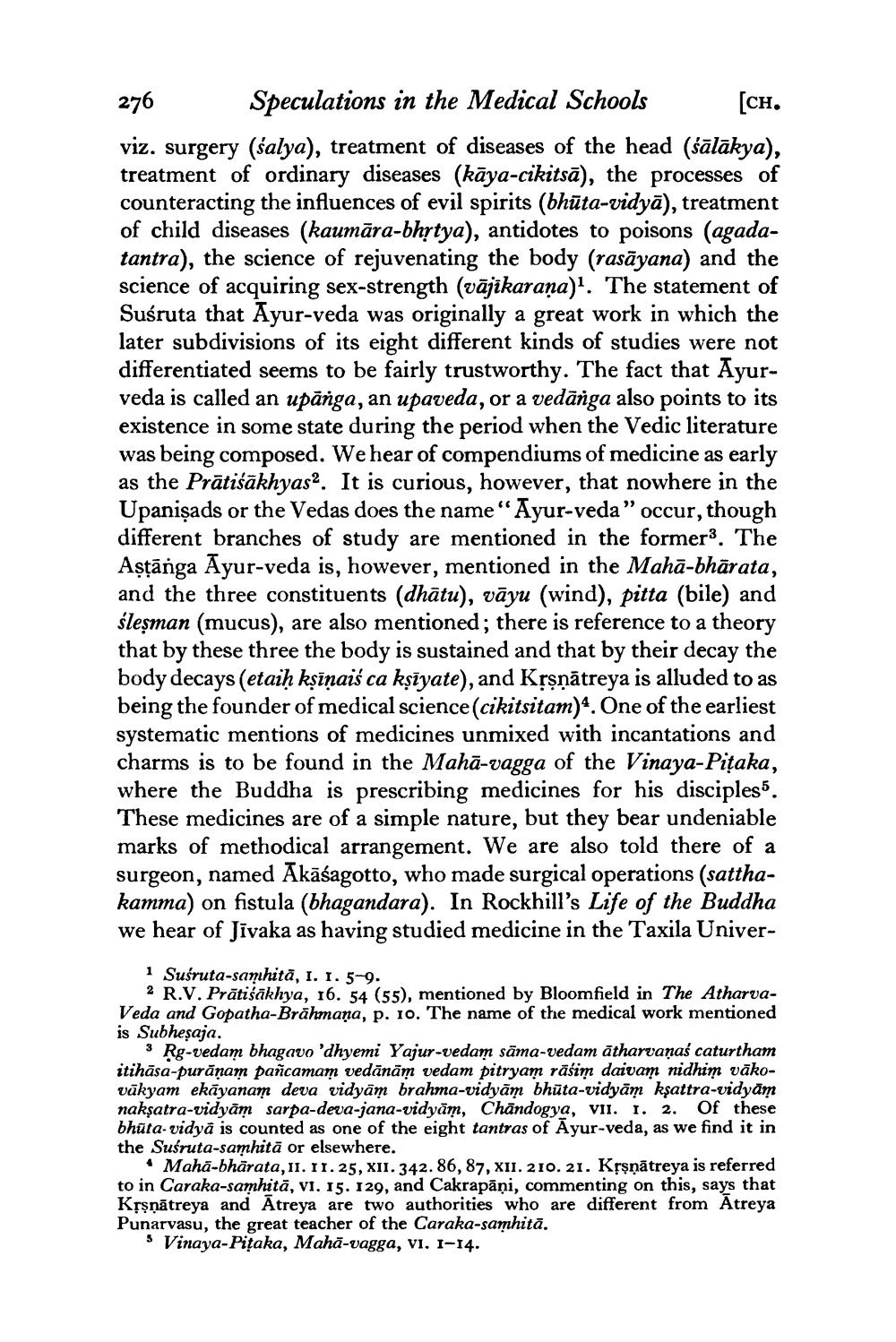________________
276 Speculations in the Medical Schools [CH. viz. surgery (šalya), treatment of diseases of the head (śālākya), treatment of ordinary diseases (kāya-cikitsā), the processes of counteracting the influences of evil spirits (bhūta-vidyā), treatment of child diseases (kaumāra-bhrtya), antidotes to poisons (agadatantra), the science of rejuvenating the body (rasāyana) and the science of acquiring sex-strength (vājikaraña)'. The statement of Suśruta that Ayur-veda was originally a great work in which the later subdivisions of its eight different kinds of studies were not differentiated seems to be fairly trustworthy. The fact that Ayurveda is called an upānga, an upaveda, or a vedānga also points to its existence in some state during the period when the Vedic literature was being composed. We hear of compendiums of medicine as early as the Prātiśākhyasa. It is curious, however, that nowhere in the Upanişads or the Vedas does the name "Ayur-veda" occur, though different branches of study are mentioned in the former». The Astānga Ayur-veda is, however, mentioned in the Mahā-bhārata, and the three constituents (dhātu), vāyu (wind), pitta (bile) and śleşman (mucus), are also mentioned; there is reference to a theory that by these three the body is sustained and that by their decay the body decays (etaiḥ kṣīņaiś ca ksīyate), and Krşņātreya is alluded to as being the founder of medical science(cikitsitam)4. One of the earliest systematic mentions of medicines unmixed with incantations and charms is to be found in the Mahā-vagga of the Vinaya-Pițaka, where the Buddha is prescribing medicines for his disciples5. These medicines are of a simple nature, but they bear undeniable marks of methodical arrangement. We are also told there of a surgeon, named Akāśagotto, who made surgical operations (satthakamma) on fistula (bhagandara). In Rockhill's Life of the Buddha we hear of Jivaka as having studied medicine in the Taxila Univer
1 Suśruta-sanhitā, 1. 1.5-9.
2 R.V. Prātiśākhya, 16. 54 (55), mentioned by Bloomfield in The AtharvaVeda and Gopatha-Brāhmaṇa, p. 10. The name of the medical work mentioned is Subhesaja.
3 Rg-vedam bhagavo 'dhyemi Yajur-vedam sama-vedam ātharvanaś caturtham itihāsa-purānam pañcamam vedānām vedam pitryam rāśim daivam nidhim vākovākyam ekāyanam deva vidyām brahma-vidyām bhūta-vidyām kşattra-vidyām nakșatra-vidyām sarpa-deva-jana-vidyām, Chandogya, VII. 1. 2. Of these bhūta-vidyā is counted as one of the eight tantras of Ayur-veda, as we find it in the Suśruta-samhitā or elsewhere.
• Mahā-bhārata, 11. 11. 25, XII. 342. 86, 87, XII. 210. 21. Krşņātreya is referred to in Caraka-samhitā, vi. 15. 129, and Cakrapāņi, commenting on this, says that Krşņātreya and Atreya are two authorities who are different from Atreya Punarvasu, the great teacher of the Caraka-samhitā.
S Vinaya-Pitaka, Mahā-vagga, vi. 1-14.




